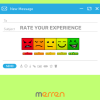In today’s business world, understanding your target audience is crucial to the success of your organization. One way to gather valuable insights into your audience’s preferences and opinions is through engaging surveys. These surveys can help improve your market research, which in turn can help you create a more effective marketing strategy, improve customer experience, and ultimately boost sales.
In this blog, we will discuss why engaging surveys matter for business insights, how to understand your target audience for effective survey creation and 10 strategies for creating engaging surveys that boost business insights. We will also cover how to choose the right survey platform for your business needs and analyze and maximize business insights from survey results. Lastly, we’ll give examples of effective and engaging surveys in the business world to inspire your next survey project.
Why Making Survey Engaging Matter?
Effective surveys are a crucial tool for businesses seeking to gain valuable insights into their customers’ needs and preferences. By engaging respondents with well-designed questionnaires, companies can obtain more accurate data for analysis and identify areas for improvement in products or services.
Additionally, such surveys can help organizations anticipate trends and remain competitive in the market. With higher response rates, businesses can gather more meaningful feedback on customer satisfaction and loyalty, leading to better business decisions and improved outcomes.
Understanding Your Target Audience for Effective Survey Creation
To create effective surveys, it’s crucial to understand your target audience. Defining your audience and their preferences is the foundation for crafting relevant questions that will yield valuable insights. Using language that is clear and easy to understand for your target audience is equally important to maintain engagement. Remember to keep the length of the survey in mind as longer questionnaires can lead to respondent fatigue.
Balancing open-ended and closed-ended questions can help gather both qualitative and quantitative data while avoiding bias in question phrasing or answer options that could influence response rates or results. Finally, test the questionnaire with a small group before launching it, analyzing its effectiveness to ensure its success with your wider audience.
Demographics

Understanding the demographics of your target audience is crucial when designing engaging surveys. Factors such as age, gender, and location can influence how people respond to questions, and tailoring questions accordingly can increase response rates.
Demographic data can also be used to segment survey results and gain deeper insights into specific groups. However, it’s essential to remain mindful of any potential biases or assumptions that may arise when analyzing demographic data, ensuring that survey results accurately represent the target audience.
Psychographics

Understanding the psychographics of your target audience is paramount to creating engaging surveys that yield insightful data. By tapping into their personality traits, values, and interests, you can tailor your questions to their preferences and generate more meaningful responses. Obtaining psychographic data is easier than ever with online tools such as social media insights and customer feedback forms. Incorporating this data in your surveys can help you better comprehend consumer behavior and make informed business decisions. Don’t overlook the power of psychographics when crafting questionnaires that captivate respondents and deliver valuable insights.
10 Strategies for Creating Engaging Surveys That Boost Business Insights
Crafting engaging surveys is crucial for businesses to gain valuable insights into consumer behavior and preferences. By following these ten strategies, you can create surveys that not only boost response rates but also provide valuable information for making informed business decisions. Firstly, defining your objectives helps you design questions in line with your research goals. Secondly, keeping the questionnaire simple and short encourages respondents to complete the survey. Thirdly, personalizing the survey based on demographics or past purchase behavior can help tailor
questions to specific interests. Lastly, analyzing results and taking action based on feedback can help improve products, services or marketing strategies.
#1 Relevance Matters. Customize Your Survey for Your Audience

Personalizing your survey according to your audience can significantly improve response rates and the quality of data collected. When designing your survey questions, consider factors such as age, gender, occupation, and location to tailor them specifically for your target audience. Also, use language that is appropriate for your respondents and avoid technical jargon or confusing terminology. By customizing the length of the questionnaire and incorporating multimedia elements such as images or videos, you can make the survey more engaging and enhance response rates. Overall, creating a customized survey can help increase participation rates and obtain more accurate insights into customer behavior and preferences.
#2 Use Attention-Grabbing Email Invitation, Survey Headlines and Intros
When inviting customers using email, make sure the subject line is attention-grabbing and clearly communicates the purpose of the survey. A lot of people today do not open emails received from businesses and just about scan the subject line. This is why the role of an attention grabbing subject line is critical.

A clear and concise headline in the questionnaire itself can also encourage respondents to participate. An engaging introduction that explains the relevance and importance of the survey can help build interest and increase response rates. By using persuasive language and emphasizing the benefits of participation, you can motivate participants to complete the survey.
Crafting an attention-grabbing headline and introduction for your survey can also significantly increase response rates. The first thing a respondent sees is the survey title, so it’s essential to make sure it accurately reflects the survey’s purpose and is interesting enough to pique their interest. An engaging introduction should explain why their feedback is important and how it will be used in a conversational tone, avoiding technical jargon or complicated language that could confuse or turn off respondents. With a catchy headline and an effective introduction, you can ensure that your questionnaire starts on the right foot and encourages respondents to complete it.
#3 Make the Survey Personal and Conversational
Creating a personal and conversational survey can significantly increase response rates. Use friendly and informal language, and address the respondent by their name if possible. Avoid leading questions or those that could bias the response. Including open-ended questions can encourage thoughtful and detailed responses, providing valuable insights into the respondent’s viewpoints. Personalized surveys also show that you appreciate the time and effort respondents invest in taking part, increasing their likelihood of participating in future surveys.
#4 Keep Questions Short, Simple, and Specific
Clear and concise questions are essential to create an engaging survey that provides valuable insights. Long, complicated questions can confuse respondents and lead to inaccurate or incomplete answers. Therefore, keeping questions short, simple, and specific can improve the quality of responses and make it easier for people to participate. Avoid using technical jargon or complex language that may not be understood by all respondents. Instead, use clear language and avoid leading questions that may bias responses. Consider using multiple choice or rating scale questions to provide more structured responses. This approach ensures a straightforward survey experience for participants while obtaining accurate data results for businesses.
#5 Value Your Respondents’ Time
Respecting your respondents’ time is crucial when creating engaging surveys. People are busy and don’t want to spend too much time answering questions, so keeping your questionnaire short and to the point is key. Consider using skip logic or branching questions to personalize the survey experience for each respondent, and make sure your questions are clear and easy to understand. Offering incentives or rewards for completing the survey can also help boost response rates. Remember to avoid biased or leading questions that could skew the results, and test your survey with a small group of people before sending it out to ensure it is effective. By valuing your respondents’ time, you can create an engaging survey that yields valuable business insights.
#6 Add Variety to Your Questions and Response Options
When designing a questionnaire, it’s important to consider the variety of questions and response options offered. By including different types of questions, such as multiple choice, open-ended, and rating scales, you can increase engagement and gather more comprehensive data. Additionally, including both positive and negative response options can provide a more nuanced view of customer opinions. Make sure to avoid leading or biased questions and use clear and concise language in your questions and response options for improved understanding by respondents. Finally, providing incentives or rewards for completing the survey can increase engagement levels among respondents.
#7 Use Visuals to Enhance Navigation, Clarity, and Appeal
Integrating visuals into surveys can make them more appealing and easier to understand for respondents. Visuals such as icons, images, graphics, and charts can enhance navigation and improve the clarity of questions. Using relevant visuals that do not distract from the survey’s purpose can also increase respondent engagement and provide more insightful data. Moreover, including visuals in surveys can break up text-heavy sections and present data in a clear and concise manner. So, consider using visuals to enhance the overall quality of survey responses and make them more engaging for your target audience.
#8 Ensure Compatibility Across Multiple Platforms
When creating surveys, it’s critical to ensure compatibility across multiple platforms. With the proliferation of devices, including smartphones, tablets, and desktop computers, it’s essential that your survey can be accessed and completed on any device. This means ensuring a responsive design that automatically adjusts to the size and orientation of each respondent’s screen. Testing your survey on multiple devices can help identify compatibility issues and ensure a seamless experience for all respondents. By prioritizing compatibility, you’ll increase participation rates and improve the quality of data collected.
#9 Offer Incentives and Positive Feedback for Participation

Motivating survey respondents to participate is crucial for gathering accurate and relevant data. One effective strategy is to offer incentives or positive feedback for their participation. This can include discounts, free products, or gift cards, which are relevant to your target audience and business needs. Additionally, providing positive feedback can encourage respondents to continue participating and provide honest feedback. To create excitement and interest, consider offering a sweepstakes or prize for completing the survey. Clear communication about the incentive and how to redeem it can go a long way in increasing participation rates and improving the overall quality of survey responses.
#10 Timing Matters – When to Send Your Survey
Sending surveys at the right time is crucial for maximizing participation rates and collecting meaningful insights. It’s essential to avoid sending surveys during holidays or other periods when people may be less likely to respond. Consider the time of day when sending surveys, as sending them during lunch breaks or after work hours may increase response rates.
Sending the in-moment survey, i.e. close to the time of the customer’s interaction with your business, can also increase response rates and provide more accurate insights. For example, sending a survey immediately after a purchase or service experience can lead to more detailed and relevant
feedback. Additionally, avoid sending too many surveys in a short period of time, as this may lead to survey fatigue and decrease participation rates.
Additionally, sending reminder emails can help boost response rates and ensure that you receive enough feedback to generate valuable insights. Personalizing survey invitations can also make them more engaging, leading to higher participation rates and more accurate data.
#11 Use Survey Templates with Care
It is always tempting to use online survey templates as they help build survey quickly and without much effort. However, it’s important to use them with care and customize them to your specific needs. Generic survey templates may not address your unique business requirements or capture the insights you need.
Customizing survey design can help you tailor questions to your target audience and ensure that you collect relevant data.
When in doubt, seek feedback from a diverse group of people before finalizing your survey questions and design. This can help ensure that your survey is clear, concise, and effective in needing much effort. However, by their nature the survey templates are generic.
Choosing the Right Survey Platform for Your Business Needs
When it comes to choosing a survey platform for your business, customization options and branding are crucial. Look for a platform that offers flexibility in terms of designing surveys that match your company’s image. Additionally, evaluate the types of questions and response options available on the platform as well as its data analysis and reporting capabilities.
A user-friendly interface is also important for both survey creators and respondents. Lastly, consider if the platform offers integrations with other business tools such as CRMs or marketing automation software to streamline your workflow. Choosing the right survey platform can make all the difference in maximizing the business insights from your surveys.
If you are looking for a platform that will help create engaging, conversational surveys, do check Merren out.
Choose Merren for Engaging and Customizable Surveys
If you’re looking for a survey platform that can help create engaging surveys that makes it easy and fun for your customers to respond, Merren is worth checking out. Merren offers a vast choice of channels that Merren for customer feedback collection- from WhatsApp, to emails (including AMP and HTML email surveys), chatbots, in-app surveys etc.
In addition, Merren offers a variety of question types and response options, as well as advanced reporting and analysis features. And with integrations available with other business tools like CRMs and marketing automation software, you can streamline your workflow and make the most of your survey results
Analyzing and Maximizing Business Insights from Survey Results
Analyzing survey results is crucial to gain valuable insights into customer preferences and business operations. By segmenting respondents based on demographics, psychographics, or other criteria, businesses can identify patterns and trends to inform their decision-making. Using a mix of question types, such as multiple-choice, open-ended, and rating scales, can also provide more nuanced feedback. Additionally, offering incentives or rewards to participants can increase response rates and maximize the usefulness of the data collected. By following these best practices for analyzing survey results, businesses can gain a deeper understanding of their customers and make data-driven decisions that drive growth.
Importance of Data Analysis and Interpretation

Effective survey creation is only one part of the process. Data analysis and interpretation are critical for gaining meaningful insights from survey results. Organizing, cleaning, and summarizing the data can help identify patterns and trends. By using statistical tools and techniques such as regression analysis or cluster analysis, businesses can ensure accuracy in their conclusions. Interpreting the data is equally important since it involves drawing conclusions and making recommendations based on the findings. Both steps are crucial in aiding informed business decisions and improving customer satisfaction.
Ways to Maximize Business Insights from Survey Results
Effective data analysis and interpretation are key to maximizing business insights from survey results. By organizing, cleaning, and summarizing the data, businesses can identify patterns and trends that inform decision-making and improve customer experience. It’s essential to use a variety of statistical tools and techniques to ensure accuracy, including regression analysis or cluster analysis. Interpreting the data involves drawing conclusions and making recommendations based on the findings. To maximize insights, clear and concise survey questions should be designed to gather both quantitative and qualitative data. Demographic questions can also provide valuable information about audience characteristics. Additionally, visual aids such as charts or graphs can help make data
more digestible, while industry benchmarks or previous surveys can track progress over time. Sharing insights with stakeholders allows for collaboration and informed decisions based on feedback.
Conclusion
Effective and engaging surveys can provide valuable insights into various aspects of a business. By crafting well-designed questionnaires that are tailored to the target audience, companies can gather relevant data that helps them make informed decisions. Offering incentives or rewards for participation also increases response rates and ensures that more people are contributing to the findings. Additionally, incorporating visuals, such as images or videos, not only enhances engagement but also makes the survey more accessible to those who prefer taking surveys on their mobile devices. Overall, these strategies help businesses gain better insights and improve customer satisfaction.





